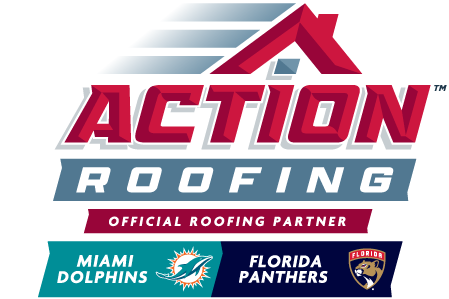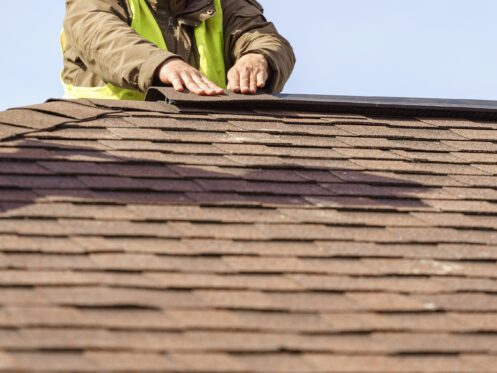Living in Florida comes with a lot of perks, like convenient access to an array of beaches, amusement parks, and world-class golf courses. However, living in Florida also requires taking precautions to protect your home from high humidity levels. Too much moisture can damage your roof in many ways that are difficult to fix, requiring major roof repairs that are in some cases could be avoided, or at least postponed, with proper maintenance.
Mold and Algae Formation
Florida’s excessive heat combined with high humidity accelerates the growth of mold and mildew, which can discolor your roof and cause damage. Once established, these elements will quickly spread across the whole roof, causing black and green stains that take away from your home’s overall aesthetic appeal.
The warm and moist air in Florida also promotes algae growth. It’s important to check the roof on a regular basis, especially the shaded parts that experience limited sunlight, for algae growth. Over time, the algae can weaken roofing materials, particularly the parts that have limestone filler in them.
Rotting Wood
High humidity can cause significant damage to the wooden parts of your roof, like the underlayment, rafters, and support beams. If not addressed, the excess moisture will lead to wood rot, compromising the structural integrity of the roof. The rot creates openings in the roof in a slow but ultimately destructive process that allows water to seep in. To keep this from happening, you must make sure the roof has proper ventilation.
Shingle Deterioration
Shingles are highly vulnerable to excess moisture because it weakens their outer layer. This not only increases wear and tear on the roof but also makes the shingles more vulnerable to harmful UV rays. You might notice cracked or curled shingles as a result. It’s also common for shingles exposed to too much moisture to lose their granules, which exposes the underlying structure to even more damage.
High humidity can also cause roofing adhesives to lose their stickiness, which can result in loose shingles. If left unfixed, the shingles are likely to blow off during storms and high winds.
Stress From Increased Weight
Florida’s humid climate doesn’t just affect the outer surface of your roof. Other roofing materials will absorb the moisture, especially those made of porous materials, like clay tiles and wood. The moisture they absorb leads to excess weight on the roof, which can cause it to sag or even partially collapse. Damage may be devastating when there is a combination of excess weight and severe rains. The best way to prevent this is to make sure the roof has adequate drainage. It also helps to use roofing materials that are resistant to water absorption.
Corrosion on Metal Components
Metal parts on roofs (e.g., screws, nails, flashing, and gutters) are vulnerable to corrosion and rusting from high humidity. The corrosion weakens these parts, reducing their ability to hold the roof securely in place. As these parts become weak and loose, the roof might leak and experience other structural issues. Florida’s salty air accelerates the rusting because salt is a catalyst for corrosion. Many roofers recommend using corrosion-resistant materials to protect the metal parts from moisture, corrosion, and rust.
Cracked Sealants
A lot of roofs have sealants added to them to serve as a waterproof barrier. Ironically, moisture itself weakens these sealants by causing them to expand and contract. This type of repeated stress eventually results in cracks and gaps in the roof. These gaps and cracks are common entry points for water, causing extensive damage to the roof’s underlying structure. Most roofers recommend resealing any deteriorated sealant to prevent water leaks and other moisture problems. They also suggest doing the resealing process before Florida’s rainy season (May through October) for extra protection.
Warping
Several parts of your roof will warp if they get exposed to high humidity. Wooden components, for example, will swell and bend in humid climates. The warping not only leaves behind an unsightly appearance but also affects the alignment and functionality of the shingles or tiles. Furthermore, it creates uneven surfaces, which can cause gaps where water can collect. Rot, mold, and more structural damage may result from water seeping into the underlying structures as it accumulates. The easiest way to address this problem is to maintain proper ventilation and to use treated wood.
Condensation in Attics
The exterior part of your roof isn’t the only thing vulnerable to high humidity. The attic space beneath the roof can experience damage when exposed to too much moisture. As warm, humid air makes its way into the attic, it will condense on cooler surfaces, like the rafters or insulation. The trapped moisture translates into mold growth, wood rot, and damaged insulation. Having sufficient ventilation and using moisture barriers may help reduce condensation and mitigate this problem.
Lower Energy Efficiency
Excess moisture reduces the roofing insulation’s ability to help regulate the temperature inside the house. The reduced effectiveness can cause higher cooling costs as the HVAC system works harder to keep the home cool. It also causes unnecessary wear and tear on the cooling equipment, which can result in premature repairs and replacements. This type of problem is especially problematic for homes in Florida because of the long cooling season. Investing in proper roof ventilation and using moisture-resistant insulation may help with indoor temperature regulation.
Increased Likelihood of Pest Infestations
Termites, ants, and other wood-destroying insects are much more likely to infest your roof and attic if you don’t take certain precautions. These pests can burrow their way into the wooden parts of the roof, leading to expensive damage. Mice and other rodents like living in cool, damp areas, making it vital to ensure proper drainage and avoid standing water. Numerous roofers also recommend sealing entry points, trimming overhanging branches, and installing pest-repellent barriers to reduce pest problems in roofs.
Efflorescence on Tiles
Clay and concrete tiles in humid climates often form a white, chalky residue on them known as efflorescence. When water gets on the tiles, it brings salts to the surface, which then leave these ugly stains. Efflorescence, however, does much more than make a roof look ugly. It also weakens tiles, causing them to crack or break. To remove efflorescence, you’ll need to hire a professional roofer. They may suggest treating the tiles with a protective sealant to prevent the accumulation of salt buildup.
Blistering of Roofing Materials
High humidity not only causes shingles and tiles to warp but can also lead to blistering. Blistering occurs when bubbles form on the surface of the roofing materials. It damages the roof’s protective layers, making it more prone to leaks and UV damage. Florida’s high temperatures combined with the high humidity exacerbate the risk of blistering. Monitoring for deterioration and ensuring adequate attic ventilation to dissipate heat and moisture are crucial in preventing blistering on a roof.
Operating in Pompano Beach, Stuart, and throughout the South Florida area, Action Roofing specializes in storm damage, roof replacement, roof repairs, roof inspections, and more. Call us today to schedule roof maintenance for your home to keep it protected from high humidity.




